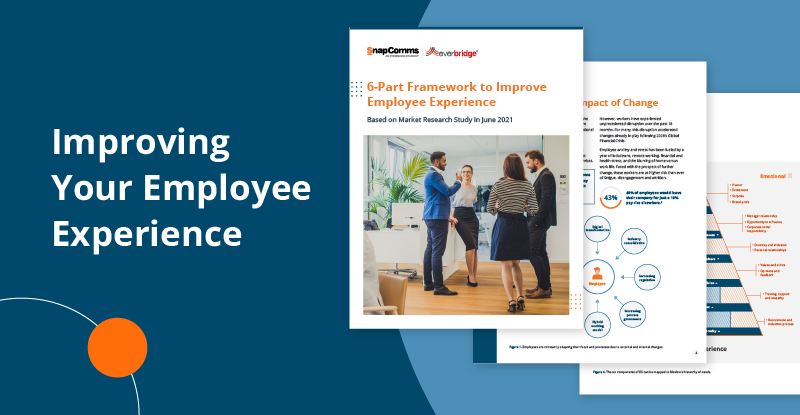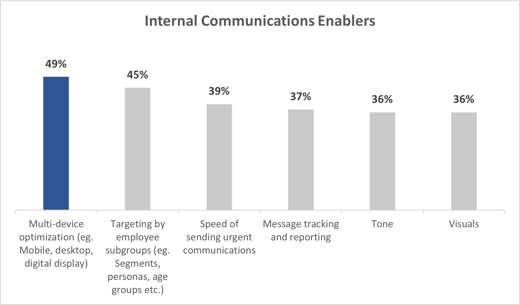
Updated August 23, 2022
One of the most powerful assets a business has is also one of its least tangible. Employee experience (EX) is a crucial influence on business performance. Positive EX strengthens an organization. Negative EX undermines it.
The benefits of employee experience are well known. Organizations that invest most on EX earn double the return on sales compared to organizations that least focus on it. Good employee experience influences positive customer experiences.
Despite its value, EX is rarely formalized. Activities are often ad-hoc, without set objectives. Measurement of results are cursory, if they are measured at all.
Employers have a significant opportunity to drive their business through a strong employee experience strategy. In this article we’ll share with you what good EX is, how to improve it and how to measure it.
And we’ll provide you a free guide with a comprehensive employee experience framework you can use in your EX activities immediately.
Contents:
1. What is Employee Experience?
2. The Benefits of Employee Experience
3. What is Good Employee Experience?
4. Seven Ways to Improve Employee Experience
5. How to Measure Employee Experience
6. Employee Experience in Corporate Workplaces
7. Download Employee Experience Whitepaper
What is Employee Experience?
Before we can focus on improving EX, we need to define what it means.
McKinsey and Company define employee experience as “Companies and their people working together to create personalized, authentic experiences that ignite passion and tap into purpose to strengthen individual, team, and company performance.”
Employee experience is different from employee engagement. Employee experience is the sum of every interaction an employee has with their company – every conversation, every tool, every day. In the workplace, employee engagement is how employees respond; employee experience is how they feel.

Source: Mystery Applicant
Research carried out by SnapComms in June 2021 shows that EX is a combination of functional and emotional needs.
- Functional needs: Formalized information regarding role responsibilities, processes and company fit
- Emotional needs: Accepted beliefs regarding role importance, personal contributions and team fit
Functional needs include things like role expectations and accountability, compensation and benefits, and resources and tools. Emotional needs include diversity and inclusion, values and ethics, and opportunity to influence.
Employees generally require functional needs to be met before they can achieve emotional needs.
The Benefits of Employee Experience
A strong employee experience delivers a wealth of benefits to organizations. It should be an area of priority in your company's employee value proposition (EVP).
- Higher engagement and customer service - employees who are empowered and motivated provide higher levels of customer support.
- Greater productivity and quality of work - employees work more productively, with fewer errors and expend greater discretionary effort.
- Improved recruitment and onboarding - a strong and appealing employer brand makes it easier to attract and retain the best talent.
- Lower turnover and absenteeism - employers avoid the huge recruitment costs and loss of expertise when staff leave.

What is Good Employee Experience?
Knowing what employee experience means is just the beginning. Visualizing what good employee experience looks like is more helpful for businesses in making it a reality.
Focus on the things that matter to employees. What positive experiences in the workplace do they value most? Remember EX is largely intangible. It isn’t driven by freebies or company swag.
It’s about creating an ecosystem that allows employees to fulfil their potential every day. Investing their discretionary effort to perform above and beyond what’s expected.
Good EX requires tapping into employees’ purpose at work. Identifying what they’re passionate about and providing the means for them to contribute to it.
Focus on growth and pathways for personal development. Employees will invest in an organization’s future if they feel their own professional future is aligned.

The COVID-19 crisis provides a great example of businesses changing their focus on EX. At the beginning of the pandemic, employers focused on functional messages in their EX communications Things like job enablement, health and wellness, and COVID-related information.
As lockdowns persisted, employers saw increasing employee disengagement and burnout. Communications switched to more emotional messages around purpose, community and culture, often delivered by leadership, to increase employee connectivity.
Good employee experience means addressing both functional and emotional components, pivoting between the two as business needs change and areas of opportunity are revealed.
7 Ways to Improve Employee Experience
Improving an organization’s EX requires formalizing strategy and sharpening communications.
1. Collaboration
EX communications must focus on increasing employee connectedness, particularly in the flexible working environments post-COVID. Employees should be motivated to form strong connections both with colleagues and with the organization. These connections inspire greater levels of commitment, which translate into increased performance.
Use a company mobile app, and if yours is a bit outdated, give it a polish to modernize it. Employees feel a sense of social belonging through a mobile app – it mirrors their experiences in the consumer world. This fosters a sense of belonging and strengthens organizational loyalty.
2. Leadership
Managing EX is a shared responsibility, where leaders take a key role. Take a new approach to leadership messaging by increasing the visibility and transparency of senior leaders.
Make them available for AMAs or group updates. Circulate regular business updates, including their personal commentary on issues. Humanize leaders by sharing how they balance their work and home lives.

3. Development
Successful businesses are built on successful staff – develop businesses and staff in parallel. Work with employees to understand their career goals, then put things in place to support this.
Replace old-fashioned 1-to-1 performance reviews with collaborative career planning. When staff are motivated and engaged, they perform at higher levels – a win-win for everyone.
4. Innovation
Physical workspace design is crucial in supporting a company culture of creativity and innovation. Introduce distinct workspaces for different modes of working. Retire meeting rooms in favor of creative thinking zones or breakout spaces.
Traditional seating arrangements produce traditional thinking. Activity-based working approaches, in an open seating plan, can be extremely effective in reviewing and resolving business issues.
5. Communication
SnapComms research into EX reveals that getting employee attention remains a challenge for HR Managers. Breaking through the communication clutter is difficult when staff are inundated with messages.
Human Resource leaders need multi-device capability, targetability and speed to effectively communicate EX programs. Email alone is no longer enough. Modern internal communication platforms must deliver highly targeted, personalized messages which reach and engage employees, wherever they are, whichever device they’re on.

6. Feedback
Listen to staff to ensure your company core values align to the new ways of work. Use targeted focus groups to provide a unique lens on initiatives, issues, or even the business direction.
Build groups of younger employees, or those from different cultural backgrounds – especially if your markets are defined by demographics or geography. The insights gained will benefit the organization, and the greater sense of involvement will engage staff.
7. Strategy
Better employee experience needs a formalized plan and clear objectives. Employers that set objectives for EX programs see a 1.6x higher impact on company performance compared to those that don't.
Following the steps below will help set your EX program up for success from the outset.
- Gather a cross-functional working group
- Agree on objectives which align to overall business goals
- Confirm the budget available
- Survey employees to gather feedback and benchmark their experience
- Map the employee journey (throughout the employee lifecycle, from new employees to long term), including key milestones and ‘moments of truth’
- Prioritize efforts on the areas with most impact
- Develop EX initiatives and a supporting internal communication plan
- Establish a measurement framework, communicate results and celebrate achievements
How to Measure Employee Experience
An improved EX program is ultimately pointless if there’s no means of judging its success. Measuring employee experience should include addressing both leading and lagging indicators.
The most common measurement tactic used are employee sentiment surveys. Simple to set up and administer, the results from these surveys provide a valuable pulse check on your workplace.
Issues and concerns can be identified and resolved before they become problems. Opinions can be sought to avoid them festering on internal social platforms. Benchmarks can be set to assess subsequent changes.
As such, surveys are a valuable leading indicator of EX. Make sure to share the results with employees as early as possible, including actions taken.

Measure lagging indicators, such as attrition rates and absenteeism, as well. These are valuable indicators of negative EX. But because they’re only visible after the events have occurred, should be balanced with leading indicators like surveys.
Employee Experience in Corporate Workplaces
Improving employee experience can be challenging in corporate environments like financial services or professional services. Employees are busy, roles are demanding and stress levels high. Only 15% of financial services workers have high levels of engagement.
Despite this, a focus on positive EX is imperative. Once financial companies focused on EX, 53% of companies saw an increase in trust in the company and 49% of companies saw improvements in productivity, according to SnapComms research.
Based on this research, we identified six key areas which most positively affect employee experience, engagement and productivity. These six components can be mapped to a hierarchy of needs as shown in this employee experience framework.

Each row of the employee needs pyramid is made up of a combination of functional and emotional needs. These hold true whether staff work centrally on-site or for digital employee experience.
The proportion of each differs depending on the overall need. For example, the employee need for Job Security and Stability is principally dependent on functional needs. These include role expectations, accountability and recruitment and induction process. There's a much smaller aspect of emotional needs.
Conversely, the employee need for Job Purpose and Esteem is based mostly upon emotional needs (such as manager relationships, recognition and ability to influence), with very little dependent on functional needs.
Successful employee experience management means dedicating most time to the lowest levels of the chart. If employees’ basic needs of job stability and security, enablement, and leadership and vision aren’t met, they will never be able to attain full job purpose and esteem or delight.
Focusing efforts on the lower levels first allows businesses to then progress up the hierarchy towards achieving more emotional, higher-level needs.

Internal communication is key to achieving positive employee engagement. Research has demonstrated that communication is the most significant factor in maximizing the potential of employees in financial services – more important than pay or other benefits.
Equally, poor internal communications erode EX. A third of those surveyed in financial services companies rated it a negative influence, higher than any other factor.
 Download Employee Experience Whitepaper
Download Employee Experience Whitepaper
Improve your company's employee experience with this free guide, featuring the full hierarchy of needs framework and tactical recommendations for EX strategies and communication.
And it’s yours to have immediately by completing the form below. Your employees – and the business – will thank you for it.


